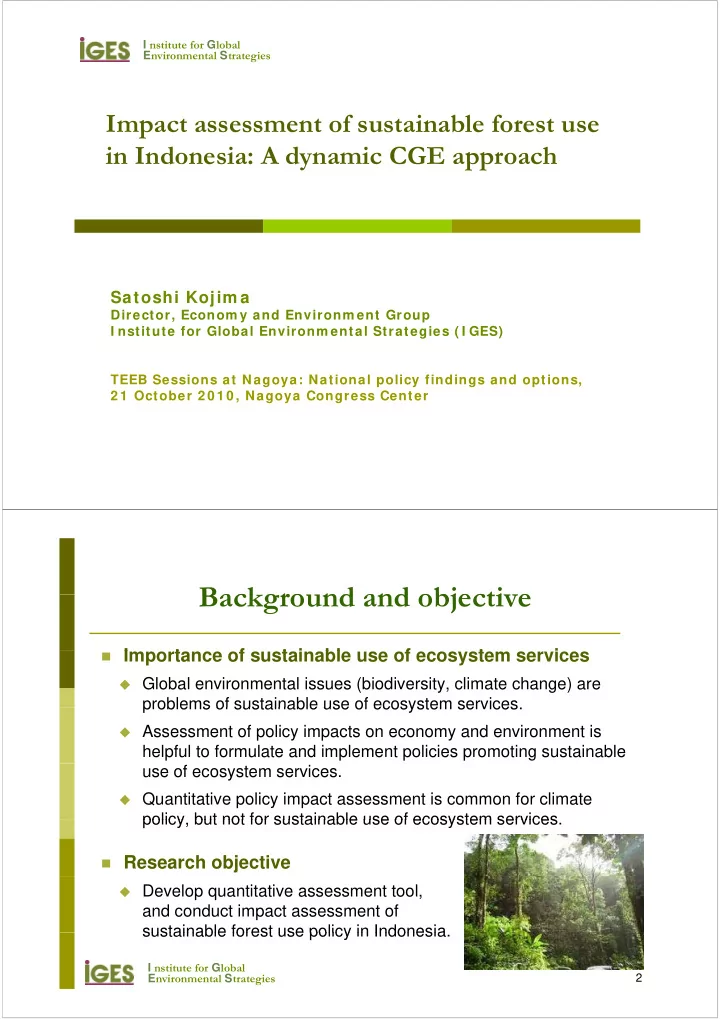

I nstitute for G lobal E nvironmental S trategies Impact assessment of sustainable forest use in Indonesia: A dynamic CGE approach Satoshi Kojim a Director, Econom y and Environm ent Group Di t E d E i t G I nstitute for Global Environm ental Strategies ( I GES) TEEB Sessions at Nagoya: National policy findings and options, 2 1 October 2 0 1 0 , Nagoya Congress Center Backgro nd and objective Background and objective Importance of sustainable use of ecosystem services I t f t i bl f t i Global environmental issues (biodiversity, climate change) are problems of sustainable use of ecosystem services problems of sustainable use of ecosystem services. Assessment of policy impacts on economy and environment is helpful to formulate and implement policies promoting sustainable use of ecosystem services. Quantitative policy impact assessment is common for climate policy but not for sustainable use of ecosystem services policy, but not for sustainable use of ecosystem services. Research objective Develop quantitative assessment tool, and conduct impact assessment of sustainable forest use policy in Indonesia sustainable forest use policy in Indonesia. I nstitute for G lobal E nvironmental S trategies 2
Methodolog Methodology Combination of ecological model (forest stock model) and C bi ti f l i l d l (f t t k d l) d economic model (dynamic CGE model) Forest stock model describes forest use scenarios: BAU (business- Forest stock model describes forest use scenarios: BAU (business- as-usual) scenario and SFU (sustainable forest use) scenario. Dynamic CGE (computable general equilibrium) model simulates economic consequences of BAU and SFU scenarios. The differences between BAU and SFU are policy impacts of SFU . Scenario setting S i tti BAU : Annual logging volume follows current trend (reduce 1.6% per year) ⇒ Forest stock will drastically reduce in 10 years per year). ⇒ Forest stock will drastically reduce in 10 years. SFU : ① Reduce logging volume such that forest stock will be maintained, ② afforestation, ③ revenue from REDD (reducing emissions from deforestation and forest degradation) credit ($4/t). I nstitute for G lobal E nvironmental S trategies 3 I nstitute for G lobal E nvironmental S trategies Scenarios Scenarios Logging volume (million m 3 ) 3 Unit logging cost (BAU in 2004 = 1) 3.50 600 3.00 500 2.50 400 400 BAU BAU SFU SFU BAU SFU 2.00 300 1.50 200 1.00 100 100 0.50 0 0.00 2004 2006 2008 2010 2012 2014 2004 2006 2008 2010 2012 2014 Forest stock (million m 3 ) F t t k ( illi 3 ) F Forest area (1000 ha) (1000 h ) 6,000 120,000 5,000 100,000 4,000 , 80,000 , BAU SFU 3,000 60,000 BAU SFU 2,000 40,000 1 000 1,000 20,000 20,000 0 0 2004 2006 2008 2010 2012 2014 2004 2006 2008 2010 2012 2014 4
Simulation results Sim lation res lts Impact on real GDP Impact on real GDP Social welfare impact (EV: $ per person ) Social welfare impact (EV: $ per person ) 0.0% 20 2004 2006 2008 2010 2012 2014 ‐ 1.0% 0 ‐ 20 2004 2004 2006 2006 2008 2008 2010 2010 2012 2012 2014 2014 ‐ 2.0% ‐ 3.0% ‐ 40 Net present value of EV: ‐ 4.0% 4.0% ‐ 60 60 $ - 57.5 per person $ ‐ 80 ‐ 5.0% Household income ($ per person) Household assets ($ per person) 4100 4100 1200 1200 BAU SFU BAU SFU 1100 4000 1000 3900 900 3800 800 700 3700 2004 2006 2008 2010 2012 2014 2004 2006 2008 2010 2012 2014 I nstitute for G lobal E nvironmental S trategies 5 Conclusions Concl sions Contribution of this study C t ib ti f thi t d We developed an assessment tool of sustainable ecosystem service use policy use policy. We introduced key elements of sustainable ecosystem service use, e.g. sustainable yield (or stock), cost implications of sustainable use, problems of unsustainable ecosystem use. This tool can estimate the value of ecosystem services that makes sustainable use policy beneficial to social welfare If WTP for forest sustainable use policy beneficial to social welfare. If WTP for forest stock > 0.21 $/m 3 /yr (or 9.3 $/ha/yr), positive social welfare impacts. Future tasks Elaboration of SFU policy setting Elaboration of scenarios and parameter values p I nstitute for G lobal E nvironmental S trategies 6
Recommend
More recommend